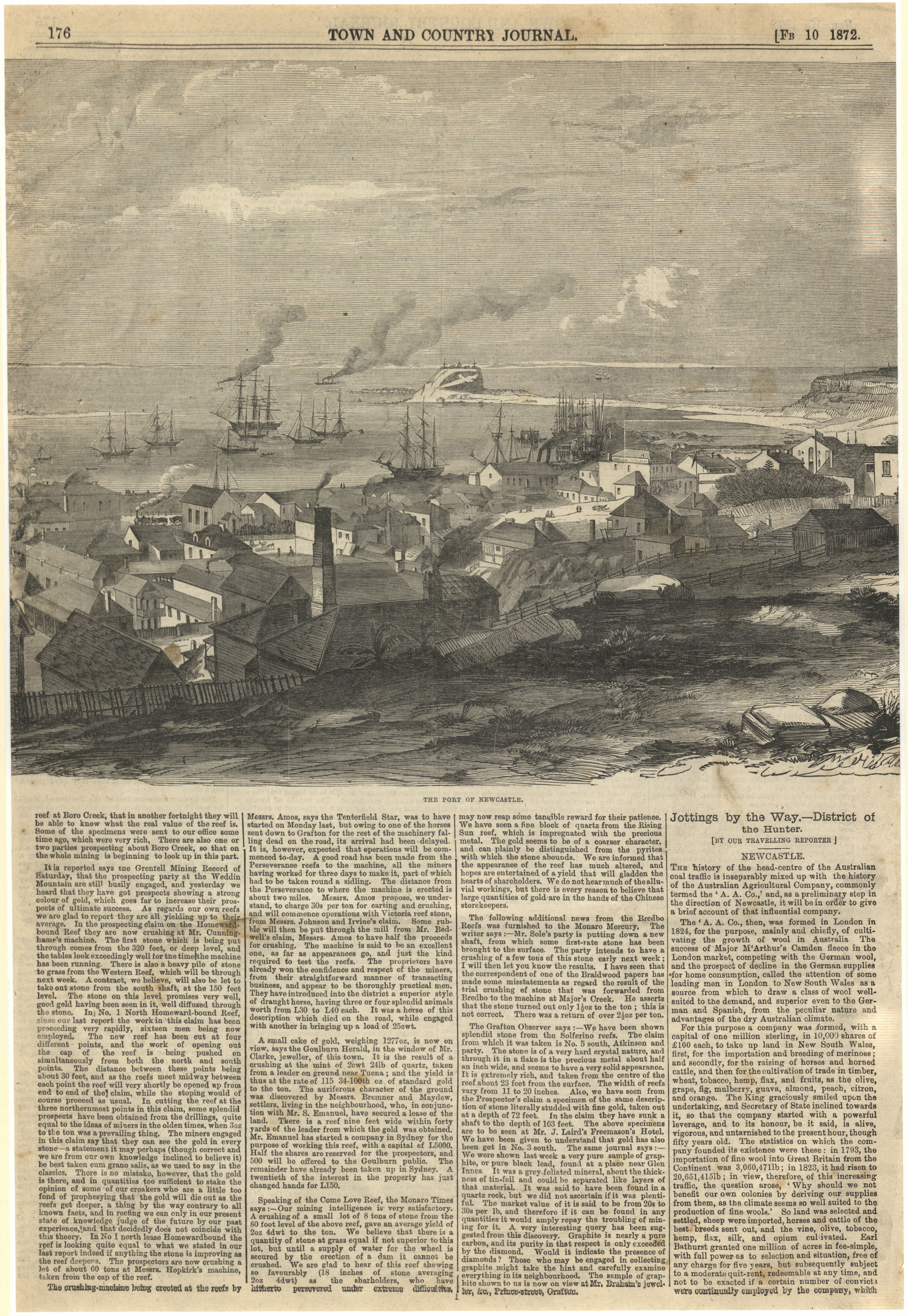Tom and Glenda Jones have kindly donated three framed engravings to the University of Newcastle’s Cultural Collections, originally published in the Town and Country Journal, and depicting Newcastle in 1872, 1889 and 1891 respectively. We have digitised them at 600dpi for closer inspection below. Click on each of the images to view the higher resolution scans. We thanks Tom and Glenda for their kind donation.

Jottings by the Way. – District of the Hunter
[BY OUR TRAVELLING REPORTER]
NEWCASTLE
The history of the head-centre of the Australian coal traffic is inseparably mixed up with the history of the Australian Agricultural Company, commonly termed the ‘A.A. Co.,’ and, as a preliminary step in the direction of Newcastle, it will be in order to give a brief account of that influential company.
The ‘A.A. Co., then, was formed in London in 1824, for the purpose, mainly and chiefly, of cultivating the growth of wool in Australia. The success of Major McArthur’s Camden Fleece in the London market, competing with the German wool, and the prospect of decline in the German supplies for home consumption, called the attention of some leading men in London to New South Wales as a source from which to draw a class of wool, well-suited to the demand, and superior even to the German and Spanish, from the peculiar nature and advantages of the dry Australian climate.
For this purpose a company was formed, with a capital of one million sterling, in 10,000 shares of £100 each, to take up land in New South Wales, first, for the importation of merinoes; and secondly, for the raising of horses and horned cattle, and then for the cultivation of trade in timber, wheat, tobacco, hemp, flax, and fruits, as the olive, grape, fig, mulberry, guava, almond, peach, citron, and orange. The King graciously smiled upon the undertaking, and Secretary of State inclined towards it, so that the company started with a powerful leveridge, and to its honour, be it said, is alive, vigorous, and untarnished to the present hour, though fifty years old. The statistics on which the company founded its existence were these: in 1793, the importation of fine wool into Great Britain from the continent was 3,060, 471lb; in 1823, it had risen to 20,651,515lb; in view, therefore, of this increasing traffic, the question arose, ‘Why should we not benefit our own colonies by deriving our supplies from them, as the climate seems so well suited to the production of fine wools.’ So land was selected and settled, sheep were imported, horses and cattle of the best breeds sent out, and the vine, olive, tobacco, hemp, flax, silk, and opium cultivated. Earl Bathurst granted one million of acres in fee-simple, with full power as to selection and situation, free of any charge for five years, but subsequently subject to a moderate quit-rent, redeemable at any time, and not to be exacted if a certain number of convicts were continually employed by the company which.. read on here: http://nla.gov.au/nla.news-article70492760

1. General view of railways goods yard, Customs House, wharf, and marine signal station.
2. Railway passenger station, Scott-street, and “The Hill.”
3. View of harbor from “The Hill.”
4. Burwood Colliery shaft
5. Stockton Coal Mine
6. Entrance to fortifications
7. A.A. Company’s new shaft, Glebe.
8. Wickham and Bullock Island Colliery.
See letterpress on page 17 here: http://nla.gov.au/nla.news-article71120852

Read accompanying story on pages 28-29: http://nla.gov.au/nla.news-article71251390
One thought on “Three Framed Engravings of Newcastle: 1872, 1889 and 1891”